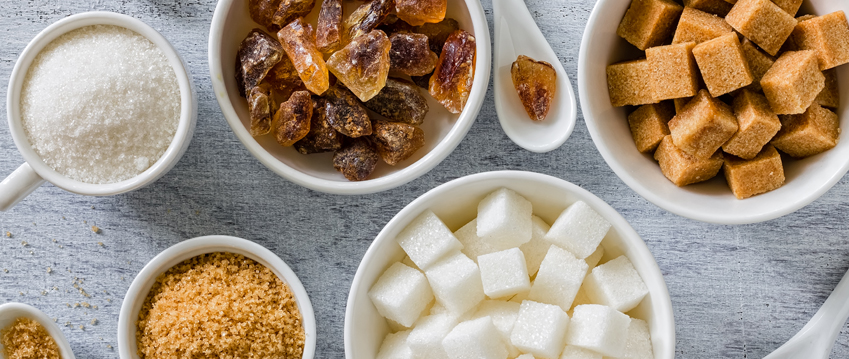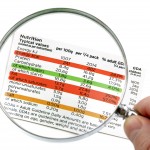


The term ‘sugar’ is generally understood to refer to table sugar – sucrose – the type of sugar which we add to our tea or use in baking. It is naturally-occurring and is extracted from sugar beet and sugar cane.
‘Sugars’ are carbohydrates – the starches and sugars in our diet which provide fuel (energy). The term ‘sugars’ covers the full range of mono– and disaccharide molecules, for example, fructose, sucrose, glucose, lactose and maltose. They occur naturally in fruits, vegetables and dairy, as well as being an ingredient used in a wide range of foods and drinks. Nutrition experts recommend that adults and children aged two years and above obtain approximately 50% of their daily calories from a variety of carbohydrate sources*. The bulk of these should come from starch-rich foods including bread, rice, pasta and other wholegrain and high fibre sources.
Starch consists of hundreds of molecules of glucose joined together. When starch is digested, it is broken down into maltose and glucose.
Use these links for more information about a healthy diet and the eatwell guide.
Did You Know?: Sugars and starches provide four Calories per gram.
Did You Know?: In the UK the main source of carbohydrate in the diet is bread*

The most common sugars in the diet fall into two main categories:
monosaccharides and disaccharides
Monosaccharides (‘Mono-‘ = one) are single molecules of sugar. The most common monosaccharides in the diet are: glucose, fructose and galactose
Did You Know?: The brain requires approximately 130g carbohydrate each day to meet its glucose needs*
Disaccharides (‘Di-’ = two) are two linked sugar molecules which are broken down into the monosaccharides by digestion. The disaccharides are: sucrose, lactose and maltose

Sugar is produced in plants, either sugar cane or sugar beet, by a process known as photosynthesis. The juice is extracted from the sugar beet or cane and impurities are removed. It is then crystallised into white sugar, which is 99.95% sucrose. Sugar is identical whether it comes from beet or cane but the climate of a geographical region is the prime influence on which is grown.
Sugar Cane – key facts:
Sugar Beet – key facts:
See our Production of Sugar section for more information

The most obvious difference between types of sugars used in the home is colour. When sugar has been extracted from the juice of the beet or cane plant, a strong tasting black syrup (known as molasses) remains.
When white sugar is made, the molasses are entirely removed, whereas brown sugars retain varying amounts of this natural coloured and flavoured syrup. The more molasses in brown sugar, the stickier the crystals, the darker the colour and the stronger the flavour, for example, muscovado sugar. However, the presence of molasses does not change sugar’s nutritional value.
These commonly-used sugars vary in colour, flavour and crystal size:
Did You Know?: A level teaspoon of sugar (4g) provides 16 Calories

Most carbohydrates will end up as glucose to provide that vital energy, as it is absorbed more quickly than other sources of energy such as fat or protein.
The Glycaemic Index (GI) is a measure of blood glucose response to foods after eating (postprandial glycaemic effect). The effects of carbohydrate-containing foods are measured against the same quantity of a reference source, usually 50g of glucose (GI 100)*, and ranked according to how quickly glucose is released, from slow-release (low GI) to quick-release (high GI).
Many factors can affect GI. This can include cooking method, how the food is stored or processed and other components of the food, for example, moisture content or ripeness of a fruit*. The matrix of a food can also affect the rate at which glucose is absorbed.
Foods with a high GI aren’t necessarily bad for you, just as those with a lower GI may not necessarily be better for you. Eating lower GI foods can help regulate blood glucose levels but it is important to ensure balance to maintain energy levels.
Glycaemic Load (GL) is a measure which takes into account the quantity of carbohydrate in a food and its GI value to indicate the overall effect of a portion of food on blood glucose levels*.
GL can be calculated as follows:
GI x Carbohydrate (g) content per portion ÷ 100
For example: 1 apple
GI of 36 x 15g carbohydrate per portion ÷ 100
= GL of 1 apple is 6 (low)
For more information, visit the Glycemic Index Foundation

Sweetener: sugar is added to foods or drinks to make them taste more pleasant. For example, to balance the bitterness of coffee or reduce the tartness of sour fruit
Did You Know: Jams must contain at least 60% sugar to comply with food standards regulations in England*

 Interpreting food labels can be confusing. By law, manufacturers are now required to list all ingredients on food labels, with ingredients shown by weight in descending order1. Nutrition labelling also includes values for both carbohydrates and sugars2.
Interpreting food labels can be confusing. By law, manufacturers are now required to list all ingredients on food labels, with ingredients shown by weight in descending order1. Nutrition labelling also includes values for both carbohydrates and sugars2.
How are sugars labelled?
Despite common perceptions, ingredients cannot be ‘hidden’ in our food. They may, however, be listed in different ways. The list below highlights some of the more common terms for sugars:
Label claims such as ‘no added sugar’ indicate foods where sugars, i.e. mono-or disaccharides, have not been added. However these foods may still taste sweet due to naturally-occurring sugars. ‘Low sugars’ or ‘sugars-free’ claims can only be made where foods contain no more than 0.5g of sugars per 100g or 100ml4.
Other sugars terminology may include: